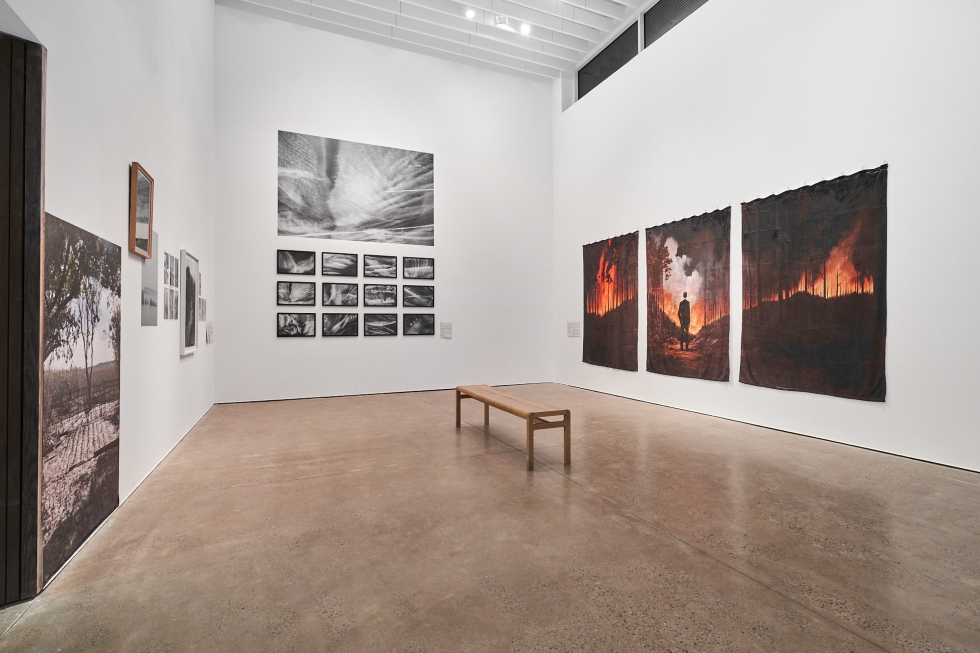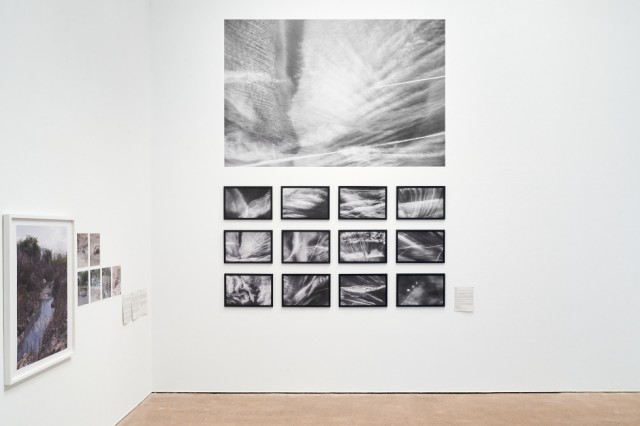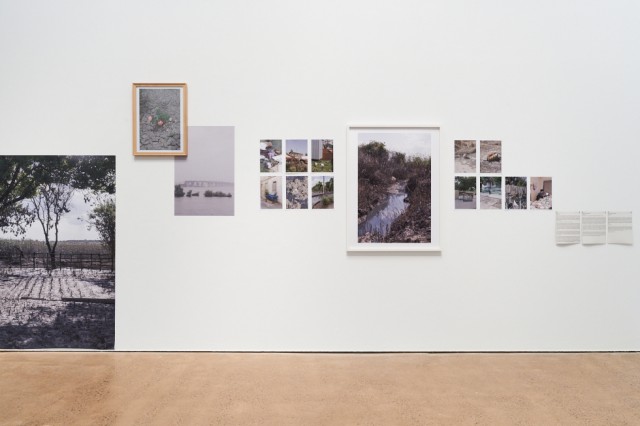Visions of the Anthropocene: LOOK Climate Lab – Reviewed

In an age of images, how can photography respond to environmental catastrophe – both impending and historical? An exhibition at Open Eye Gallery wrestles with the question…
How can we use photography to talk about climate change? This question is the departure point for a new exhibition exploring the medium’s role in the context of our impact on the planet.
The responses presented at Open Eye Gallery’s LOOK Climate Lab 2024 come in a plethora of forms. Among them, Mishka Henner, who used AI to produce the imagined documentary photography of his large-scale, three-panel work. Made during a residency at Salford University, in them we find a man, dressed smartly for the office, amid a blazing forest fire. He faces the oncoming flames with a nonchalant indifference, no doubt able to feel – but nevertheless ignore – their searing, encroaching heat.
It’s not a subtle work because, surely, it asserts, the time for subtlety is behind us. Titled Executive Decision, for Henner, it addresses the curious reality in which we find ourselves: “Never before have we been so closely connected to global climate events,” while, ironically, simultaneously, having “never been so detached from the natural world.” It’s a gut-punch of an opening act.

Adjacent is John Davies’ tonally very different Cirrus Aviaticus, a suite of 13 black and white infrared photographs of the skies above Liverpool and Lancashire. As the title suggests, they are of beautiful cirrus clouds; like sprawling castles in the sky. After an initial period of gazing passively at their immense gorgeousness, however, the contrails of aircraft can be spotted – essentially streaks of aviation waste products, they have the effect of inducing and perpetuating the clouds they intersect.
Like a stunning night sky over and in the vicinity of a power station that we might initially think of as natural, almost sublime, they are nothing more than the frozen result of a chemical reaction. In Davies’ photographs is the paradox that speaks to our relationship with the planet we call home, and the hand we have in continuing to destroy it.
The way we treat the world and each other is to the fore in Nazar Furyk’s pictures of Kherson, Ukraine. They record the aftermath of the destruction of a hydroelectric powerplant dam in the conflict with Russia, which resulted in the ongoing contamination of the immediate area – from gas stations, petroleum reserves and agrochemical storage, all of which found its way into the nearby Black Sea.
Through Furyk’s lens we see all manner of detritus: a collection of books, a discarded football and household rubbish. But there is resilience, too. In a poignant pairing, one photograph shows a bridge on the Dnieper River lain to waste, while its partner image invites us to believe in the possibility that something can be salvaged still; in parched ground, a metaphor, as flowers find a way to not just endure, but bloom.

Nearby, Stephanie Wynne’s Erosion project is part time machine, taking us back to the post-1945 discarding of tonnes of rubble from the bombed homes of Liverpool and Bootle on the nearby Crosby coast. People are conspicuous by their absence. We see instead suggestions: bricks, concrete and warped girders; wind turbines and a luridly glowing sky. Scrutinising the impact of warfare on place at a remove of decades rather than, by contrast, the on-the-spot terrible immediacy of Furyk’s work, Wynne’s photographs present the practical outcomes of conflict, while also suggesting its leftovers, its ashes.
In her book Islands of Abandonment, writer Cal Flynn ponders “Life in the Post-Human Landscape.” I mention this because it feels very much of a piece with the Wigan-based post-industrial reflections of Lizzie King and Mario Popham, who each capture life brought to the brink (and its recovery, given an opportunity). In the crucible of Wigan Flashes nature reserve, King produces microcosmic dystopias of sorts. Using what she calls a process of “co-creation with the environment,” in which photographic paper is used to capture the “elements and life of this site,” the almost alien results, with their petroleum-tinged pools and wastelands, call to mind the Zone of Arkady and Boris Strugatsky’s Roadside Picnic.
Popham’s evocatively titled Strange Eden series responds to Bickershaw Country Park. These images, capturing our species’ impact on the area, refer to its former incarnation as a coal mine and, fittingly, include material mined there to reflect on that recent past. But they also indicate the fluid nature of, well, nature; which, the artist says, moves through “states of decay and creation; darkness and radiance.” Such language, and Popham’s experimenting with AI, might put us in mind of science fiction; only it isn’t. This is here, this is now.
LOOK Climate Lab reasserts once again photography’s role as a medium of record. As Open Eye curator Max Gorbatskyi says: “When taking a photograph today, it is probable that you capture a result or a cause of the climate crisis since its manifestations are ubiquitously around us.” Visual culture should reflect the world, and provoke. This exhibition’s Anthropocene-inflected visions turn the questions at its heart back at us, the viewer, as if to ask: When are we going to act?
Mike Pinnington
LOOK Climate Lab 2024 continues @ Open Eye Gallery, Liverpool until 31 March
Images: © Rob Battersby





